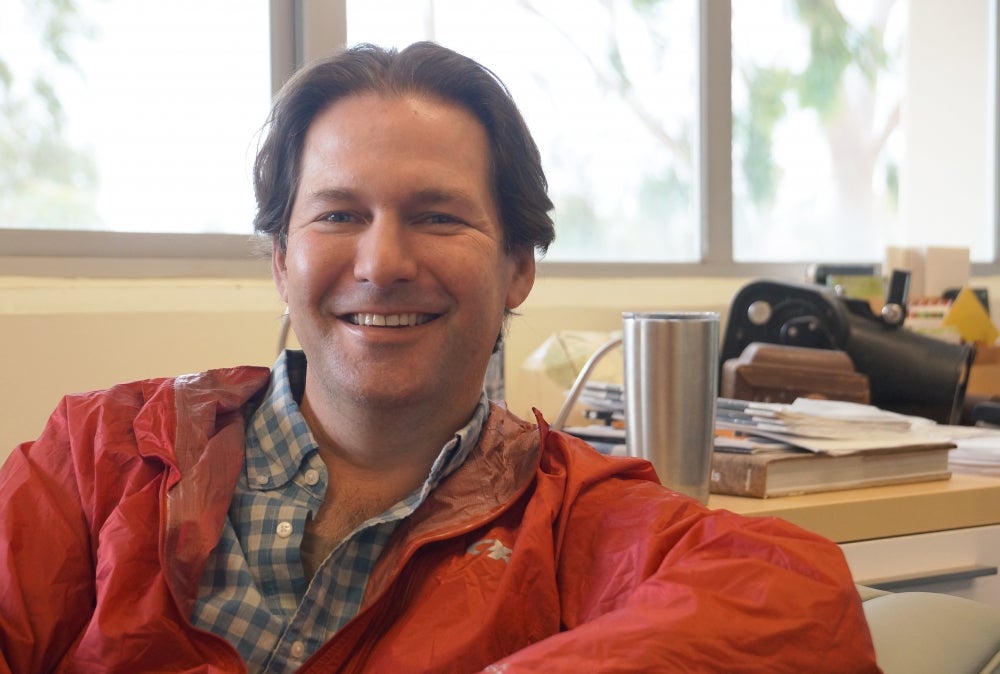
Eyes in the Sky

We love our bad-boy (and -girl) artificial intelligences — think Skynet or Hal 9000 — pushing people and societies to the brink of ruin, and telling a good science fiction story in the process.
But what if, in real life, we used the massive computational powers of artificial intelligence (AI) for good, making it the hero of our epic endeavor to save humanity from, say, the effects of climate change?
This is the story UC Santa Barbara ecohydrologist Kelly Caylor wants to tell. And now, with an AI for Earth Innovation grant sponsored by National Geographic and Microsoft, he and colleagues Matt McCabe from King Abdullah University of Science and Technology in Saudi Arabia, and Lyndon Estes from Clark University in Massachusetts, are beginning a new chapter in the global effort to adapt to a rapidly changing Earth. At UC Santa Barbara, the team also will consist of Ryan Avery, a doctoral student in geography, and Marc Mayes, an Earth Research Institute scientist.
“There is a real big movement — which is really exciting — to take advantage of the next generation of satellite data, ground-based observations and just a whole new set of technologies around being able to monitor environmental processes, and the potential to use those in conservation, or to support efforts to better manage landscapes,” said Caylor, who is also a professor at UCSB's Bren School of Environmental Science & Management, with research specialties in hydrology, terrestrial ecology and coupled natural-human systems.
The project is an extension of work already being done on the ground and from the sky, as Caylor and colleagues have, for years, monitored field sites and satellite images to get a sense of climate conditions and water availability that could indicate the health of crops and other vegetation in sub-Saharan Africa.
“In Zambia, where I do a lot of fieldwork, there are a lot of subsistence farmers who are still planting crops based on the timing of rainfall and are really trying to deal with rainfall variability in a very traditional way,” Caylor said. “We’re trying to help them by giving them better data. And we’ve built sensors that can monitor rainfall and things like that.”
It’s an effective system, and one that has proven itself in times of climate change, where variability can lead to drought and subsequent food insecurity. But Caylor and his team are also interested in all the water we can’t see from the surface — namely, groundwater. This other major component of water use in agriculture is being more heavily utilized as investors both domestic and foreign lease large tracts of land on the continent to develop or grow crops.
One huge indicator of groundwater use, Caylor explained, is the center pivot agriculture system. The method creates a large, often circular crop field watered by slowly-rotating sprinklers that extend outward from a central well, irrigated by the water therein. In a place as big as the African continent, for example, much of this takes place in remote areas, according to Caylor.
“We’ve seen this happening but it’s hard to get a picture of it on the ground,” he said. “And so we got to thinking about all this new satellite data that’s out there. We’ve got companies that are launching these micro satellites that can map the whole Earth at two- to three-meter resolution every day. And so from those we can start to see not only where these fields are as they’re being installed but also what’s growing in them and how often the water is being applied. We now have the capability to look down and see these things. But to do it you have to be looking at really large scales and you have to be able to quickly process lots and lots of data.”
Enter artificial intelligence and, for Caylor’s group, the chance to scale up from provincial fields in Zambia to the entire African continent. Instead of round-the-clock human eyeballs searching for these telltale signs of aquifer-tapping, computer vision is used to classify images that look like center pivot-irrigated fields, with help from the world’s premiere mapping organization and one of the world’s leading technology companies.
“It’s a great three-way partnership,” Caylor said. The research ideas developed at UC Santa Barbara are enhanced by the large-scale data, computational and workflow management tools that are Microsoft’s forte, while National Geographic’s experience in communication and visualization is valuable as the scientists try to convey their findings into actionable items.
“They see the value of doing this as we do, in terms of connecting this kind of information we can share to help people make decisions about water management and understand land use change,” noted Caylor. “Is there encroachment in conservation areas? Do we need to be worried about the expansion of these areas into places where we’re trying to preserve wildlife?”
The project is still in its beginning stages, as the scientists face the same challenge every computer vision researcher faces with his or her AI: training it well enough to recognize every version of its target image.
“Computer vision algorithms are pretty good, but they can get sensitive to things that we don’t realize,” Caylor explained. While computer vision might find center pivot-irrigated fields in Africa, it might struggle to find the same in New Mexico, for instance, because surrounding soils and vegetation are different. Or, it might find a baseball field and call it an agricultural field.
Fortunately, Caylor, McCabe, Estes and the rest of the team are off to a good start, with decades of research and data to build on, and resources that can help them both refine and scale up their approach as they embark on this most ambitious land-use study — not to mention the enthusiasm and energy to help solve one of the biggest environmental problems we face.
“The main goal is to empower people who are worried or interested in thinking about water management issues and conservation of water and land in areas where those things are transforming really rapidly,” Caylor said. “We have a great team of people and we’re all going to throw ourselves into this problem.”



